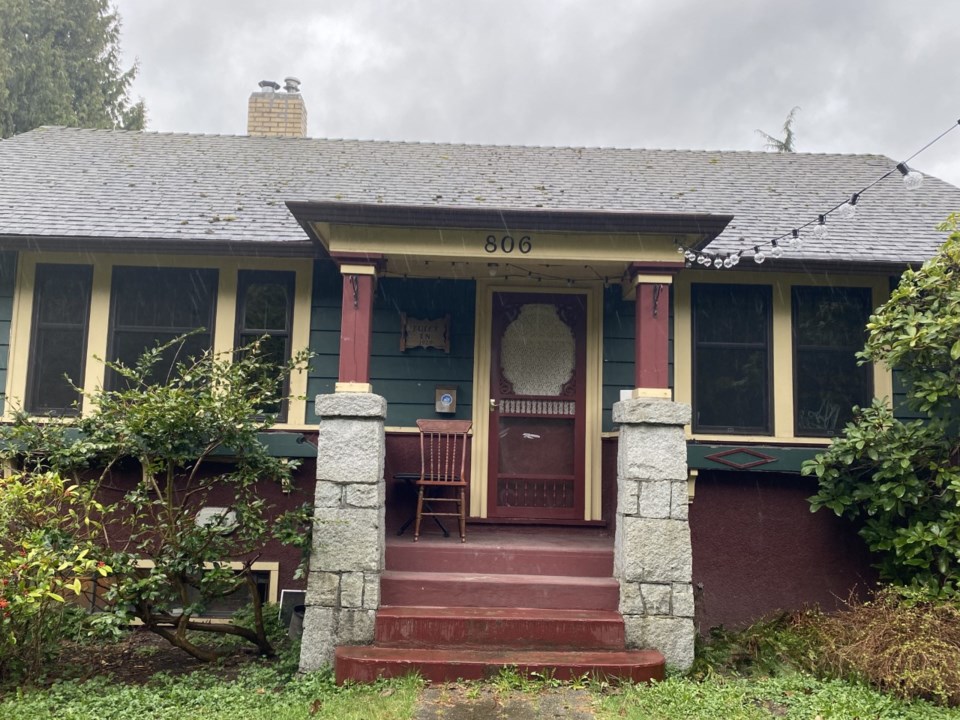A 1929 house in the Moody Park neighbourhood will be restored and preserved as part of a townhouse project approved by council.
The Sincock House, located at 806 Eighth St., will be relocated to a new spot on the development site, where it will be restored and receive heritage designation. Following a March 27 public hearing, council supported a heritage revitalization agreement application for 802 and 806 Eighth St. and 809 Eighth Ave., which allows for the construction of 18 townhouse units in three buildings and retention of the heritage house.
As part of the proposal, the house would be restored and legally protected through a heritage designation bylaw. The restoration plan includes construction of a new concrete foundation, preservation of the home’s wood and stucco finishes, preservation of the original 1929 wood flower boxes and original wood windows, reshingling of the roof in a practice done in the first half of the 20th century, and painting the home in a colour scheme that is authentic to the 1920s – based on the original colours found on the house and in house catalogues of the time
At the public hearing, Coun. Daniel Fontaine asked staff about the heritage value of the home, noting it’s quite a simple home and doesn’t stand out architecturally like some of the heritage homes in the Queen’s Park neighbourhood.
“I believe the building itself was constructed out of the catalogue,” he said. “Just for my own benefit, are a lot of our heritage homes … that have been pulled out of a catalogue and are now deemed to be of heritage value, or is this unique in that respect?”
Jackie Teed, the city’s acting director of climate action, planning and development, said this heritage revitalization agreement (HRA) is a “fairly unique” situation. Recalling HRAs done in recent years, she said there have not been many – or any – catalogue houses.
“When we look at our HRA applications, we consider a lot of different aspects of heritage, including whether they represent different components of history in the city,” she explained. “So a lot of times, what is valuable in terms of a heritage asset, whether it's a house or some other thing in our community, isn't necessarily the obvious … the beautiful and the beautifully maintained Edwardian house.”
Teed noted there are various reasons why homes could be considered significant.
“It could be something that really represents a part of the city's history. It could be a component that we have very few other examples of it could be an outstanding example of that particular thing,” she said. “So, while it might not be readily apparent to everybody who looks to see that really big, spectacular house as an HRA, it's definitely an important piece of the city's history.”
What’s so special about this pattern book house?
A statement of significance provided to the city about the Sincock House said the home is valued for its direct association with the interwar development boom in New Westminster, centred around the late 1920s, when new neighbourhoods were developed in the city, and existing neighbourhoods, such as Moody Park, were filled in.
“This period saw the major expansion and development of the park itself which coincided with, and likely helped to spark, the filling in of the remaining empty residential lots in the Moody Park neighbourhood,” said the report.
According to the statement of significance report, the home’s owners, Thomas and Stella Sincock, had “enduring impacts” on the social and physical development of New West in the first half of the 20th century. The house also represents the work of local residential building contractors, Bodley & Sons, who built numerous homes in the Burnaby and New Westminster areas in the interwar period.
While modest in scale, the statement of significance noted the house is valued as a working-class 1920’s Craftsman bungalow and features high-quality craftsmanship and finishing.
“This building type represents the trending working-class house designs popularized in house plan catalogues of the 1920s often utilized in the construction of the over 500 new homes built between 1927 and 1929 in New Westminster’s ‘bungalow boom,’” said the report. “It contributes to the dominant historic character of the Moody Park streetscapes along the park which were filled in in the 1920s and 30s with ‘bungalow homes.’”
Local historian Jim Wolf has long been fascinated by “pattern book houses” and has researched homes whose designs came out of catalogues – including his own. In early 2022, he showed how pattern books were used to design homes from modest cottages to stately Victorian mansions in a presentation to the New Westminster Heritage Preservation Society called Building by the Book: New Westminster Houses from Architectural Pattern Books 1865 to 1940.
The 1894 Galbraith House, which sits on the corner of Eighth Street and Queens Avenue, is an example of a catalogue home. It was based on a design by a New York architect that was featured in a pattern book.
“You get a lot of tinkering with different plan books to create something that makes sense for the owner and the builder. So that’s what’s fascinating about it,” Wolf told the Record in a 2022 interview. “The plan books had a huge influence, but they were adapted to local conditions.




